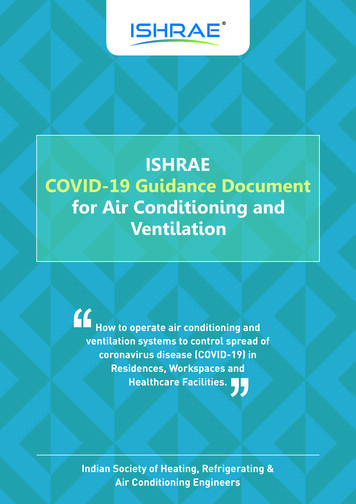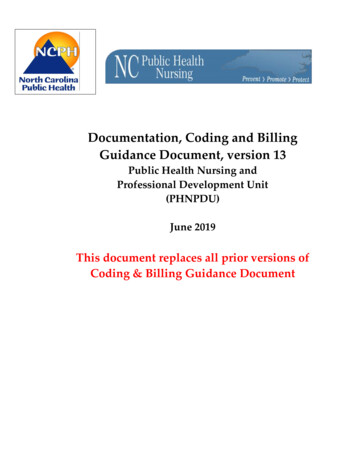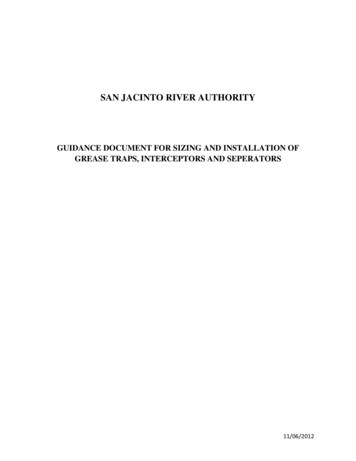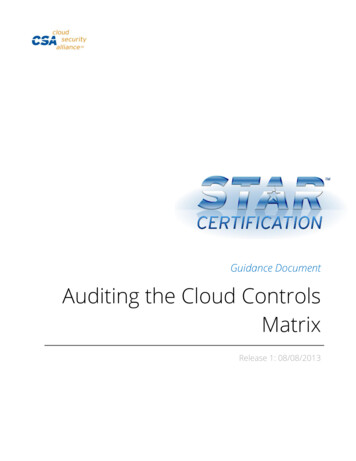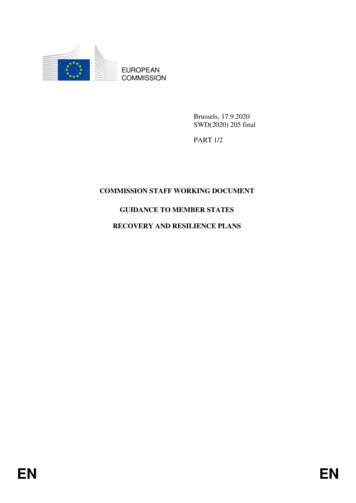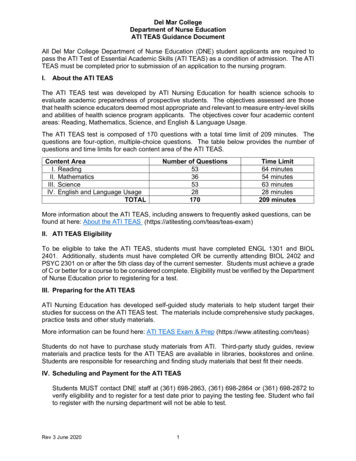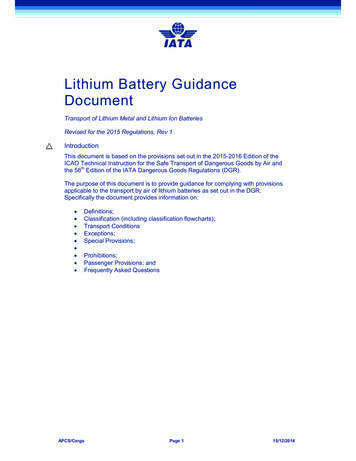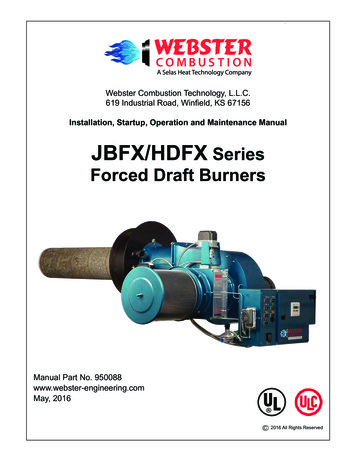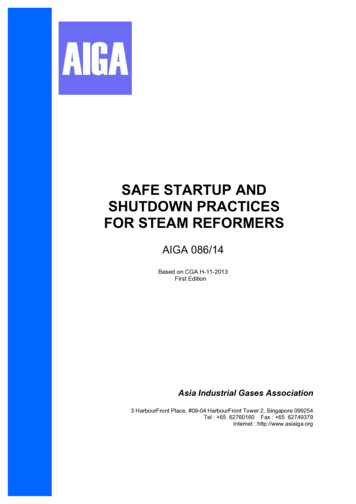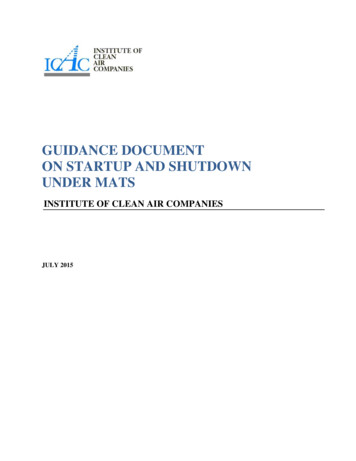
Transcription
GUIDANCE DOCUMENTON STARTUP AND SHUTDOWNUNDER MATSINSTITUTE OF CLEAN AIR COMPANIESJULY 2015
Guidance Document on Startup andShutdown under MATSAbstract: The Mercury and Air Toxics Standards (MATS) rule as well as the Industrial BoilerMaximum Achievable Control Technology (MACT) rule contain provisions related to monitoringand operation of air pollution control (APC) equipment during startup and shutdown of coalfired boilers. Periods of operation, especially during boiler startup, are characterized by rapidtransient changes in flue gas composition, quantity, temperature, and moisture conditions.Between a coal-fired boiler and stack, the APC equipment and systems may include selectivenon-catalytic reduction (SNCR), selective catalytic reduction (SCR), dry sorbent injection (DSI),activated carbon injection (ACI), wet or dry flue gas desulfurization (FGD), and particulatecollectors such as an ESP, a fabric filter baghouse or both. For startup and shutdown conditions,the APC equipment and systems cannot be viewed as single standalone entities anymore butmust be viewed as an integrated APC system with proper operation not only dependent on theboiler flue gas characteristics but also dependent on the proper operation or the lack thereof ofthe APC equipment upstream. The objective of this document is to provide operators of coalfired boilers with guidance on safe and effective methods of starting the APC equipment and onmeasurement issues in order to comply with EPA’s startup and shutdown provisions in theMATS and IB MACT rules as well as startup rules that become part of operating permits.Guidance Document Workgroup:Connie Senior, ADA-ES, Inc., Workgroup LeaderTony Licata, Licata Energy & Environmental Consulting, Inc.Kevin Dougherty, Fuel Tech, Inc.Sheila Glesmann, ADA Carbon Solutions, LLC, ICAC Mercury Control Division Co-ChairRichard Mimna, Calgon Carbon CorporationPete Zemek, MKS Instruments, Inc.Bob Davis, TRC Environmental Corp.Angelos Kokkinos, Babcock Power Inc.Mark Calloway, MC IndustrialCliff Brown, Novinda Corp.Kevin Cosman, KC Cottrell, Inc.Jim Butz, NovindaCindy Khalaf, Johnson Matthey Stationary Emissions Control, LLCSteve Scavuzzo, Babcock & Wilcox1
ICACCopyright Institute of Clean Air Companies, Inc., 2015All rights reserved.3033 Wilson Blvd, Suite 700Arlington, VA 22201Telephone: 571.858.3707Fax: 703.243.8696Betsy Natz, Executive Directorbnatz@icac.com2
Guidance Document on Startup andShutdown under MATSTable of Contents1Introduction . 41.1. Who is ICAC . 41.2.2Overview of MATS Startup and Shutdown Provisions . 52.1Introduction . 52.234678Startup Provisions . 62.2.1Option 1 . 62.2.2Option 2 . 72.3Shutdown Provisions. 72.4Other Provisions of the Rule . 8Summary of the Startup and Shutdown Processes in Coal-Fired Boilers . 8Measurements during Startup and Shutdown . 134.1CEMS issues. 134.1.1Flow . 144.1.2Calibrations . 144.1.3Temperature and Moisture . 154.25Objectives. 4Special considerations for mercury measurement: CEMS and sorbent traps . 15Equipment . 165.1LNB/OFA . 165.2SNCR . 165.3SCR . 175.4Dry Sorbent Injection for Acid Gas Control . 205.5Sorbent Injection for Mercury Control . 215.6ESP. 225.7Baghouse . 235.8DFGD . 245.9WFGD . 25Summary . 25References . 28List of Acronyms and Abbreviations . 293
1 Introduction1.1. Who is ICACThe Institute of Clean Air Companies (ICAC) is the national non-profit trade association of companiesthat supply air pollution control and monitoring systems, equipment, reagents, and services forstationary sources. ICAC has promoted the air pollution control industry and encouraged theimprovement of engineering and technical standards since 1960. Our members include over 90companies who are leading manufacturers of equipment to control and monitor emissions of particulatematter (PM), volatile organic compounds (VOC), sulfur dioxide (SO2), nitrogen oxides (NOx), hazardousair pollutants (HAP), mercury, acid gases, and greenhouse gases (GHG). Therefore, ICAC is in a uniqueposition to provide technical guidance on the startup and shutdown provisions of the Mercury and AirToxics Standard (MATS). ICAC’s collective technical expertise is, and will continue to be, an importantresource for coal-fired boilers facing challenging new regulations.1.2. ObjectivesPeriods of operation, especially during boiler startup, are characterized by rapid transient changes influe gas composition, quantity, temperature, and moisture conditions. As discussed in theEnvironmental Protection Agency (EPA) training manuals for fabric filters (FF)1 and electrostaticprecipitators (ESP)2 in the section on startup and shutdown, improper startup and shutdown can notonly damage the equipment but also result in performance degradation that may result, depending onits severity, of the ESP or fabric filter not meeting its design outlet emission requirements.Many components in modern power plants such as steam turbines and auxiliary steam systems limit andcontrol the manner that boilers start up. The problems are aggravated with installation of multiple airpollution control (APC) equipment and processes, especially those required to achieve Mercury and AirToxics Standards (MATS) compliance. Between a coal-fired utility boiler and stack, the APC equipmentand systems may include selective non-catalytic reduction (SNCR), selective catalytic reduction (SCR),dry sorbent injection (DSI), activated carbon injection (ACI), wet or dry flue gas desulfurization (FGD),and particulate collectors such as an ESP, a fabric filter baghouse or both. For startup and shutdownconditions, the APC equipment and systems cannot be viewed as single standalone entities anymore butmust be viewed as an integrated APC system with proper operation not only dependent on the boilerflue gas characteristics but also dependent on the proper operation or the lack thereof of the APCequipment upstream.The problems related to low flue gas temperature during boiler startup can also occur on boilershutdown. Corrosion problems can develop in the boiler and throughout the flue gas path. Only a fewexamples have been presented of the performance degradation that can occur if particulate controlequipment is started up prematurely. It is critical that proper startup and shutdown procedures aredeveloped and followed for an integrated APC system installation to assure that the APC equipmentoperates at optimum levels to meet design gaseous and particulate emissions removal requirementswhen desired boiler load is reached.The objective of this document is to provide operators of coal-fired boilers with guidance on safe andeffective methods of starting the APC equipment and on measurement issues in order to comply withEPA’s startup and shutdown provisions in the MATS rule and the Utility NSPS. In addition we anticipate4
that startup and shutdown rules may be added to operating permits for plants that may not be coveredby the MATS rule. This document provides general guidance for good engineering practice for coal firedplants.2Overview of MATS Startup and Shutdown Provisions2.1 IntroductionThe MATS startup and shutdown provisions apply to both electricity generating units (EGUs) andindustrial boilers. This overview does not include an analysis of the rules related to integratedgasification combined cycle (IGCC) plants.These rules apply to startup and shutdown under MATS and to the startup and shutdown provisions forthe PM standard in the utility New Source Performance Standard (NSPS), and industrial boiler (IB)National Emission Standards for Hazardous Air Pollutants (NESHAP), i.e. IB Maximum Achievable ControlTechnology (MACT). The November 19, 2014 rule amends the startup and shutdown provisions of theMATS rule and utility NSPS finalized in February 2012, and aligns the requirements with IB MACT (40 CFR63 Subpart DDDDD). The NSPS part of this rule only covers particulate (PM) emissions. Based on recentcourt decisions, EPA has directed states to make changes to Startup and Shutdown provisions in airpermits by issuing a State Implementation Plan (SIP) call for consistency with the new startup andshutdown rules.EPA states that it believes that the final rule includes enough variability for sources to concludecompliance without controls for a short period after startup is possible, and also that the bestperforming sources, those that use clean fuels for the longest period of time before the introduction ofcoal, can meet the standard during startup and shutdown periods. However, EPA acknowledges that forstartup and shutdown periods, there is a lack of hazardous air pollutant (HAP) data and there are somechallenges with measurements, and these have led EPA to establish work practice standards. EPAdescribes this November 2014 final rule as “very similar” to and no more stringent than the February2012 final rule’s requirements. In summary this final rule: Finalizes the startup and shutdown requirements in February 2012 rule (Option 1 in the finalrule).Provides alternative work practice standard as an option for startup (Option 2 in the final rule).For a given EGU, emissions data may be identified as being within a startup period or a shutdownperiod, and emissions data within these periods will not be included in the compliance averaging period.However, both continuous monitoring system (CMS) measurements and certain recordkeeping andreporting requirements apply to startup periods and shutdown periods. The rule is based on a 30-day or90-day boiler operating averaging period for emissions and EPA’s belief that sources can over-control tomake up for periods when their emissions are higher than the rolling average limit. Theoretically, if unitstability is not achieved for some reason within the defined startup period, this can still be averaged outover the full 30 or 90 days.EPA used a statistical approach to determine the best performing 12 percent of EGUs by selecting thoseEGUs that were able to engage their Air Pollution Control Devices (APCDs) most quickly after the initialgeneration of electricity or thermal energy.3 These data were obtained from EPA’s Clean Air Markets5
Division (CAMD). EPA averaged that time to determine the end of the startup period when the numericstandards for currently regulated criteria pollutants would become applicable.2.2 Startup ProvisionsEPA’s rulemaking allows the operator to select one of two methods of determining compliance duringstartup periods, Option 1 and Option 2 as described below. Both options have the following things incomm
The problems related to low flue gas temperature during boiler startup can also occur on boiler shutdown. Corrosion problems can develop in the boiler and throughout the flue gas path. Only a few examples have been presented of the performance degradation that can occur if particulate control equipment is started up prematurely. It is critical that proper startup and shutdown procedures are
